
WHEN I walked the full length of Brooklyn’s Kent Avenue from DeKalb Avenue north to Franklin Street and North 14th Street in 2008, I was documenting a road that experienced a great deal of change since the way it was in the 1970s, when I traveled it in a rickety van with a group of other teenagers from our school on Washington Avenue to a long gone bowling alley in Greenpoint on Humboldt Street. At that time its north end was given over to breweries (most famously, Schaefer), warehouses, factories and the railroads that connected all of them and there was nary a thought that it would become a boulevard lined with luxury high rise residences and parks. A 2005 zoning change paved the way for the new buildings and conversions seen along Kent Avenue today.
While I saw the last of Kent Avenue industry in 2008, when I decided to travel it again in 2022 I found a nearly completely different road as most of its old flavor had disappeared. But not all, and I tried to snap as much of the old stuff as I could. Instead of my 2008 trip, this time I traveled north to south. It wasn’t a great day for photography with dark clouds, which cleared somewhat later in the day. I used the magic of Photoshop to brighten up some of the photos.

Looking south on Kent Avenue from North 13th Street. For several years, Kent Avenue has been reduced to one northbound traffic lane, with the rest given over to parking and bike lanes. Dominating the view is 1S1, or #1 South 1st Street, and the eternal Williamsburg Bridge.

25 Kent, between North 12th and North 13th Streets, is an office building constructed from 2017-2019.
The New York City real-estate developer Rubenstein Partners is willing to offer a nearly 50% discount on rent and more flexible terms than a typical lease — all to convince tech and media companies that opening an office in Brooklyn will compel their employees to return to work in person. [Insider]
Unfortunately, 25 Kent opened just before the COVID-19 Pandemic, when working from home became very popular. 25 Kent isn’t located near any subway lines, either (a 9-block walk to the G train Nassau Avenue station, which is doable but unpleasant in rainy or cold weather), which makes it an unusual location for offices.
Personally, I miss offices as I have worked at home since obtaining salaried work in 2021; but I don’t miss the commutes or bad bosses. It does get a bit repetitive at home each day, and office managers are counting on this to get people back to working traditionally.
Though much of Bushwick Inlet Park has been open for years, the northern end opposite 25 Kent has been on the books for years, as the last of Kent Avenue’s industries needed to move out first. Hopefully, within a year or two the park will be completed; Brooklyn Bridge Park also opened in parcels along the Brooklyn Heights and DUMBO waterfronts.
Some older buildings remain on Kent Avenue; here at North 11th, one hosts sports bar Kent Ale House. I noticed a chiseled “First Street” sign at the second floor. Williamsburg’s streets were formerly numbered from 1st to 12th going east from the East River; hence, Kent Avenue was 1st Street, Wythe Avenue 2nd, Berry Street 3rd, Bedford Avenue 4th, and so on. By the late 19th Century the streets had their present names.
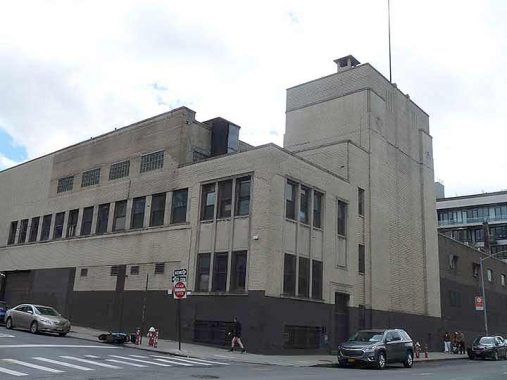
Ko Rec Type (#67 Kent avenue at North 10th Street) was a revolutionary product developed in the early 1960s, a specially formulated correction composition was adhered to a formulated paper. When you made a typo on a manual typewriter, you simply placed the piece of Ko Rec Type over the typo, and corrected it. Very neat, very clean corrections resulted. The company then developed a complete line of correction and imaging products for electronic and self correcting typewriters. The original Ko Rec Type correction paper still sells today. The company has changed with the times, and is now a leading compatible manufacturer of imaging products including ink jet carts, laser toners and fax thermal ribbons. Apparently the company had moved out of the building by 2018.
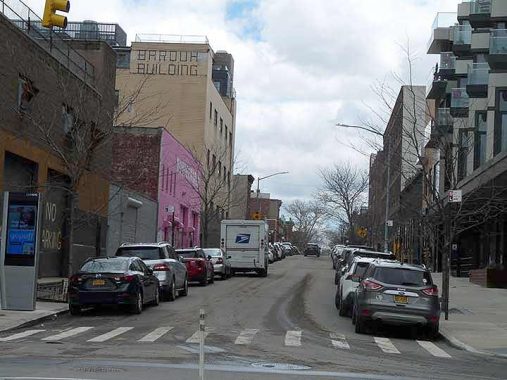
The Barouh family owned the company and their name can still be seen on another associated building around the corner on North 9th Street.

Though I think some modern buildings have their moments as far as esthetics are concerned, 56 North 9th Street, also known as 87 Kent Avenue isn’t among the ones I’m favoring, though modern architects don’t care about the tastes of webmasters in their late middle age. It does boast a comprehensive veterinary center on the ground floor.

The completed section of Bushwick Inlet State Park, between North 9th and 10th Streets, features views of the East River and the Manhattan skyline, or use the park’s facilities for active recreation. The park includes a multipurpose field for soccer, football, lacrosse, field hockey, rugby, and ultimate frisbee, a green building with a green roof, a viewing platform, playground and public access to the waterfront.
An additional park parcel between North 8th and 9th Streets is Marsha P. Johnson State Park; Johnson (1945-1992) was a transgender activist and a familiar figure in the West Village, who co-founded (with Sylvia Rivera) the group STAR (Street Transvestite Action Revolutionaries), which offered housing to homeless and transgender youth. The park stands atop former railyards that stretched between North 4th and 10th Streets. Until the 1970s, a locomotive crossing Kent Avenue was not an unusual sight.
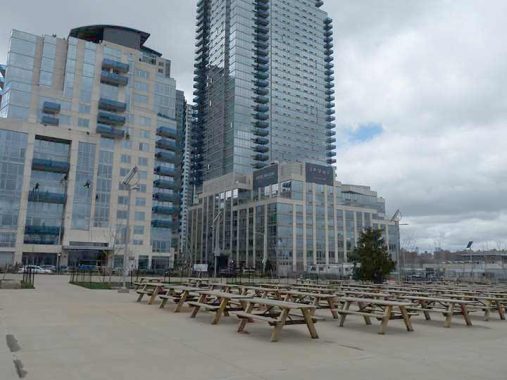
Facing Johnson Park are 34 North 7th, part of The Edge luxury complex; on the right is Level, luxury rentals. A new street, East 6th Place, was carved out to funnel traffic toward both buildings.
Those who tire of the swimming pool and Manhattan views at Level can head to Dolly’s at #101 Kent at North 8th…
So while it didn’t start off as a tribute to Dolly Parton herself [in 2020] they couldn’t pass up the opportunity. “Most bars have pictures of old men on the walls and we choose to put up all females instead, ‘Dolly’s’ from circa 1930’s – 1970’s. We also wanted to pay homage to the #1 Dolly of all time, Ms. Parton,” the spokesperson said. In the bathroom, Dolly Parton’s album covers decorate the walls, showing love to the Queen of Country. [Delish]
The corner building, though remodeled, is much older than the adjoining monstrosity along Kent Avenue.
A miraculous survivor, a handsome brick building on the west side of Kent Avenue opposite Dolly’s is the Eugene Doherty Rubber Works, 110 Kent, recently the home of Polish-American Biba’s Cafe, now closed.
Doherty, it seems, was a man of means and of no small renown. He was a leading member of the Irish community on both sides of the Newtown Creek, and stood shoulder to shoulder with Battle-Ax Gleason in the eyes of his countrymen as one of their leading members.
A manufacturer of rubber, Doherty specialized in the sort of material demanded by “turn of the 20th century” Dentists for the manufacture of dentures. His heavily advertised (see sample at bottom) Samson Rubber was a standard component used for the manufacture of false teeth. The factory, incorporated as Eugene Doherty Rubber Works, Inc., was located at 110 and 112 Kent Avenue over in Williamsburg. 110 is the brick building adjoining East River State Park for you Brooklyn folks and/or visitors to Smorgasburg. [Mitch Waxman, Brownstoner]
As I’ve mentioned this part of Kent was once lined with trainyards, train tracks, manufacturing and sugar refinneries. Trainweb offers a glimpse of those bygone days.
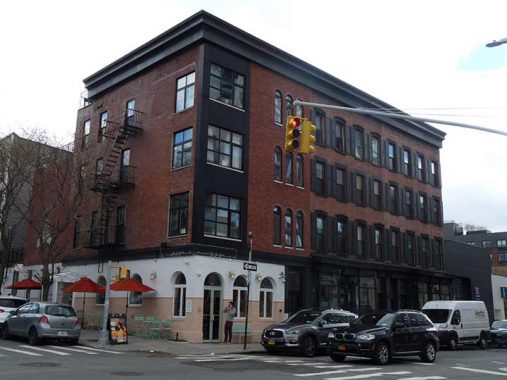
A trio of 19th Century survivors, #110-123 Kent Avenue at North 7th Street. A Mexican restaurant is on the corner and a cookie shop occupies #123; the top floors are residential. #121 and #123 have been left alone while #119 on the corner is extensively renovated.
My admiration of simply constructed brick factory buildings is well. known to Forgotten NY readers and I’m happy this one, which was once the Brooklyn Cooperage Co., manufacturers of casks and barrels, has survived as the home of Brooklyn Coachworks, a dealer of Land Rover vehicles. A rail spur once passed into the building and its right of way can still be seen between North 4th and 5th Street.

The new apartment buildings on the west side of Kent Avenue, built from 2008-2012, attempt to mimic the brick construction of the older buildings, but only approximate it.
The Austin Nichols Warehouse, #184-198 Kent Avenue between North 3rd and North 4th Street. The Austin Nichols Company was established as a wholesale grocery business by James E. Nichols and five former associates of Fitts & Austin in 1879. It grew to become the world’s largest wholesaler of comestibles and eventually came to occupy nine buildings in lower Manhattan. The decision was made to move to the Brooklyn Williamsburg waterfront in the early 1900s, and the company’s financier, Horace Havemeyer, assembled a team of architectural professionals, including the pre-eminent architect Cass Gilbert (1859-1934) who has helmed the construction of the US Customs Building at Bowling Green as well as the “Cathedral of Commerce” Woolworth tower, to construct their new headquarters.
The new plant was underway in January 1914 and opened in March the following year. Unlike the Beaux Arts masterpieces Gilbert was known for, the Austin Nichols warehouse was a vanguard of a more streamlined style that would gradually take hold during the 20th Century. The 179×440-foot plant integrated piers, railway tracks, freight elevators, conveyor belts and pneumatic tubes. The plant processed dried fruit, coffee, cheese, olives, peanut butter and other foodstuffs distributed under the Sunbeam Foods label. In 1934, Austin Nichols added liquor products; the building remained with the company until the late 1950s.
For several decades the warehouse was home to small businesses and Williamsburg lost its riverside industry as the piers disappeared (lost to container ports in New Jersey) and the railroad tracks that served the piers and the waterside businesses went away as well.
For a time in the early 2000s, the building’s fate was in question. City Councilman Simcha Felder declared that “the building is a piece of trash and should be knocked down;” nevertheless, the NYC Landmarks Preservation Commission voted to landmark the building in September 2005. The City Council, however, in a rare step, reversed the ruling in November of the same year and overrode Mayor Michael Bloomberg’s veto. Soon after the building was sold but its new owners qualified for the Federal Historic Preservation Tax Incentive Program, which enables its revival. The Austin Nichols Building has been completely restored and refurbished as a private apartment building, with a waterside walkway open to the public.
Next week: Domino, the Williamsburg, the Navy Yard. Meanwhile, check the Kent Avenue link at the top of the page, as the avenue was rather more interesting in 2008.
As always, “comment…as you see fit.” I earn a small payment when you click on any ad on the site.
6/4/23


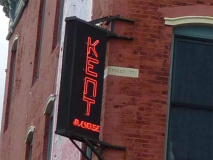
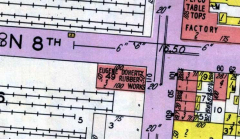
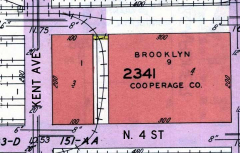
3 comments
My father worked for Austin Nichols starting back when they were in the grocery business only, later distilling liquor Wild Turkey, he stayed with them when they moved to a new plant in Queens and left when they moved out of state in the late 1970s. I remember the building well as I grew up on the North side of Williamsburg, Brooklyn, NY.
Even though I’m constantly blasting NYC for getting rid of industry, the loss of the seaport business to New Jersey was more or less inevitable. Containerized shipping became completely dominant in the world starting in the 1960’s and each port requires huge tracts of land. That land was available in New Jersey but not in the city,
My aunt and uncle lived in an apartment on Kent Ave. When I was young and my family paid a visit, I remembered that there was no bathroom in their apartment and the bathroom was down the hall that was shared by other residents.